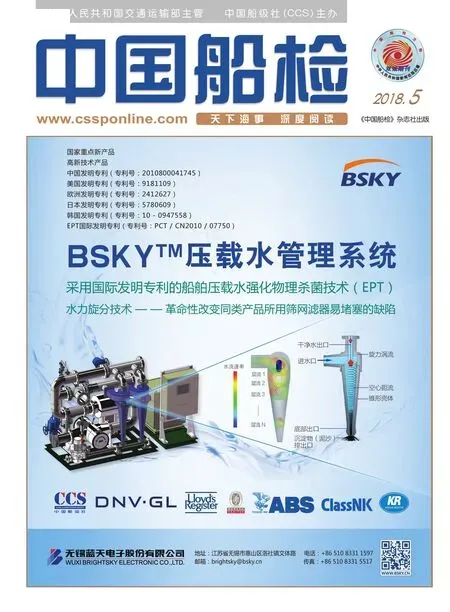Key factors affecting the crude oil newbuilding market
By Tan Song
The development of the crude oil newbuilding market in the future depends on the trade demand of the crude oil fl eet, the replacement demand, and the continuous strategic and speculative demand in the market.
At present, the overall age of the crude oil fleet is 10.17 years, and the size of the crude oil ships within 10 years reach 232 million DWT, accounting for 60%of the crude oil fleet. The dismantling age of the oil tanker is usually about 22 years, taking into account the previous dismantling data of the crude oil ship, as well as the probability of speeding up dismantling ships by shipowners caused by such factors as the entry into force of the ballast water convention, the emission of sul fi de and the emission requirements of the ECA area,the model of crude oil ship dismantling was established.

From 2018 to 2022, the dismantling amount of crude oil ship fl eet will be signi fi cantly increased, and the volume of dismantling is expected to reach 22 million DWT in 2020, of which the new dismantling amount caused by environmental protection standards is 5.5 million DWT. Due to the fleet dismantled ahead of schedule,the dismantling amount of the fleet will be reduced after 2023. According to our forecast, the dismantling volume of crude oil ship will be up to 23.2 million DWT in 2031. In the short term, when the volume of dismantling of the fleet is increased, the shipping market is generally poor. In the medium and long term,the dismantling volume of the fleet will increase the replacement demand of the shipowner. From this point of view, the increase in dismantling volume of the fl eet around 2020 may increase the new demand, and the peak of the dismantling at around 2031 may also cause the peak of ship order.
Compared with the price ten years ago, the price ofeach ship type was basically at a tragically low level. At present, the actual shipbuilding price was signi fi cantly lower than the digital level reflected by the new ship guidance price considering the RMB appreciation,in fl ation, the increase of labor cost and the increase of shipbuilding costs caused by the implementation of the new shipbuilding regulations in the last ten years.In addition, due to the in fl uence of market supply and demand factors and the rising cost of raw materials such as steel at this stage, there is a limited space for further decline in shipbuilding prices. At present, shipbuilding prices are at a historical low level, and it is possible for investors to increase investment in new vessels.
At present, the top 11 shipowners of the crude oil fleet account for 33.1% of the global crude oil fleet.The 11 shipowners include both shipping companies from major oil importing countries such as China’s COSCO Shipping, China Merchants, Japanese MOL,and those from crude oil exporters such as Iran national gas company, Saudi national shipping company and Malaysia national petroleum corporation. Due to the large scale effect of the shipping industry, with the fi erce competition in the market and the frequent mergers and acquisitions between enterprises, the energy transport enterprises are moving toward large size and large scale.One of the reasons to order ships for the high quality ship owners is to win the future with the younger, more advanced and lower cost fl eet. Based on the purpose of energy security, the oil transport companies from China also need to meet the overall national strategy. Due to the low superimposed ship price and strict environmental protection requirements, some high-quality shipowners may take the opportunity to increase their fl eet size and adjust their fleet structure.At present, the global handheld orders stand at 199 million DWT, calculated by 100 million DWT in delivery each year, the current handheld orders can not meet the requirements of the shipyard for the next two years. At present, the cruise oil ships from modern heavy industry,Daewoo shipbuilding, and Samsung heavy industry in South Korea, have made up 51.3% of the existing crude oil fleet. South Korea, which receives mainly oil tanker orders, has only 47.89 million DWT handheld orders,which is the lowest guarantee coefficient of handheld among three countries i.e. China, Japan and South Korea.Although the construction of most shipyard facilities is universal, the main shipyards in South Korea are expected to increase their marketing efforts in crude oil ships.
In the long run, the Juglar cycle of shipbuilding market,determined by the ship age, will play a role and will lay the main logic for the market of new shipbuilding of oil tankers. In the medium term, the imbalance between supply and demand of the crude oil fleet will restrict the pace of the new shipbuilding market, and the crude oil ship will not have the great prosperity driven by the supply shortage, and the dismantling of the fl eet brought by the effective environmental rules will benefit the marginal improvement of the supply and demand of the crude oil fl eet. In the short term, in 2018, the global economy is expected to maintain the momentum of 2017,the volume of crude oil trade will continue to grow, and the price of new ship is in low level, which will bene fi t the new ship market. However, due to the low freight of crude oil ships, there is still room for the decrease of the hand-held orders of crude oil ships, which will restrict the enthusiasm of new ship orders. It is expected that in 2018, the volume of new crude oil ships will be slightly lower than 2017.

